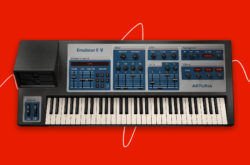Arturia’s V Collection 8 brings several fabulous new instruments that faithfully emulate classic synths, pianos, and keyboards.
Included in the V Collection 8’s newest offerings is the Jun-6 V, which emulates the Roland Juno-6 – the legendary six-voice synthesizer that served as the foundation for the equally iconic Juno-60 and Juno-106 models.
The history of the Juno-6
The Juno-6 was the first polyphonic synth priced under $2,000. Although that’s still obviously a lot of money (especially in 1982), its competitors were completely inaccessible to everyone except high-budget studios. The Fairlight CMI Series II, for example, was also launched in 1982 – but it started at a cool £30,000. With the release of the Juno series, Roland allowed a (slightly) larger contingent of home musicians to afford their very own polyphonic synthesizer.
The anatomy of the Juno-6
The Juno-6 had no patch storage memory, meaning that users couldn’t save their own patches. Without this feature, there were a few workarounds for recreating a given sound – you could try to memorize patches, use masking tape creatively to mark knob and fader positions, or draw a patch diagram. Let’s just say that clicking “Save Preset” in the V Collection emulation today is a little bit easier.
The Juno-6 also didn’t feature MIDI capabilities – if you wanted a sound from the synth, you had to physically touch the keys at your desired timing and velocity instead of programming in the synth parts you wanted. While this was in ways expected at the time of its release, today many musicians and producers can’t imagine a world without the flexibility of MIDI.
The legacy of the Juno-6
Even in modern times, producers continue to revere the Juno-6 for its sound design capabilities. Typically characterizing it as ‘rich’ and ‘full,’ Juno-6 users praise the synth for its pad, string, and brass options. The keyboard’s two distinct choruses imbue Juno patches with expansive, lush stereo effects that quickly became sonic staples.
Thanks to its signature timbres, popularity, and affordability, the Juno sound is now essentially synonymous with the ’80s. Let’s round out this overview with a few classic songs from the decade that use Juno synths:
Try Jun-6 V and other synth emulations for free with a three-day trial of Arturia’s V Collection 8, and then Rent-to-Own the collection for $24.99/mo until you own it outright:
December 29, 2020



